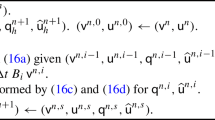Abstract
The simultaneous-approximation-term (SAT) approach to applying boundary conditions for the compressible Navier-Stokes equations is analyzed with respect to the errors associated with the formulation’s weak enforcement of the boundary data. Three numerical examples are presented which illustrate the relationship between the penalty parameters and the accuracy; two examples are fundamentally acoustic and the third is viscous. The viscous problem is further analyzed by a continuous model whose solution is known analytically and which approximates the discrete problem. From the analysis it is found that at early times an overshoot in the boundary values relative to the boundary data can be expected for all values of the penalty parameters but whose amplitude reduces with the inverse of the parameter. Likewise, the long-time behavior exhibits a t −1/2 relaxation towards the specified data, but with a very small amplitude. Based on these data it is evident that large values of the penalty parameters are not required for accuracies comparable to those obtained by a more traditional characteristics-based method. It is further found that for curvilinear boundaries the SAT approach is superior to the locally one-dimensional inviscid characteristic approach.
Similar content being viewed by others
References
Nordstöm, J., Svärd, M.: Well-posed boundary conditions for the Navier-Stokes equations. SIAM J. Numer. Anal. 43(3), 1231–1255 (2005)
Svärd, M., Carpenter, M.H., Nordström, J.: A stable high-order finite difference scheme for the compressible Navier-Stokes equations, far-field boundary conditions. J. Comput. Phys. 225, 1020–1038 (2007)
Svärd, M., Nordström, J.: A stable high-order finite difference scheme for the compresible Navier-Stokes equations: no-slip wall boundary conditions. J. Comput. Phys. 227, 4805–4824 (2008)
Strand, B.: Summation by parts for finite difference approximations for d/dx. J. Comput. Phys. 110, 47–67 (1994)
Lele, S.K.: Compact finite difference schemes with spectral-like resolution. J. Comput. Phys. 103, 16–42 (1992)
Mattsson, K., Svärd, M., Nordström, J.: Stable and accurate artificial dissipation. J. Sci. Comput. 21(1), 57–79 (2004)
Svärd, M.: On coordinate transformations for summation-by-parts operators. J. Sci. Comput. 20(1), 29–42 (2004)
Carpenter, M.H., Gottlieb, D., Abarbenel, S.: Time-stable boundary conditions for finite difference schemes involving hyperbolic systems: methodology and application for high-order compact schemes. J. Comput. Phys. 111, 220–236 (1994)
Poinsot, T.J., Lele, S.K.: Boundary conditions for direct simulations of compressible viscous flows. J. Comput. Phys. 101, 104–129 (1992)
Kim, J., Bodony, D.J., Freund, J.B.: LES investigation of a Mach 1.3 jet with and without plasma actuators. In: AIAA Paper 2009-0290, Presented at the 47th Aerospace Sciences Meeting & Exhibit, January 2009
Mattsson, K., Iourokina, I., Ham, F.: Towards a stable and accurate coupling of compressible and incompressible flow solvers. In: Annual Research Briefs, Center for Turbulence Research, Stanford, California, USA, pp. 31–41 (2005)
Vinokur, M.: Conservation equations of gasdynamics in curvilinear coordinate systems. J. Comput. Phys. 14, 105–125 (1974)
Pulliam, T.H., Chaussee, D.S.: A diagonal form of an implicit approximate-factorization algorithm. J. Comput. Phys. 43, 357–372 (1981)
Kim, J.W., Lee, D.J.: Generalized characteristic boundary conditions for computational aeroacoustics. AIAA J. 38(11), 2040–2049 (2000)
Lodato, G., Domingo, P., Vervisch, L.: Three-dimensional boundary conditions for direct and large-eddy simulation of compressible viscous flows. J. Comput. Phys. 227, 5105–5143 (2008)
Carpenter, M.H., Kennedy, C.A., Bijl, H., Viken, S.A., Vasta, V.N.: Fourth-order Runge-Kutta schemes for fluid mechanics applications. J. Sci. Comput. 25(1–2), 157–194 (2005)
Hardin, J.C., Ristorcelli, J.R., Tam, C.K.W. (eds.): ICASE/LaRC Workshop on Benchmark Problems in Computational Aeroacoustics (CAA). No. NASA CP-3300 (1995)
Tam, C.K.W., Hardin, J.C. (eds.): Second Computational Aeroacoustics (CAA) Workshop on Benchmark Problems. No. NASA CP-3352 (1997)
Tam, C.K.W., Hu, F.Q.: An optimized multi-dimensional interpolation scheme for computational aeroacoustics applications using overset grids. Presented at the 10th AIAA/CEAS Aeroacoustics Conference, AIAA Paper 2004-2812 (2004)
Kim, J.W., Lee, D.J.: Generalized characteristic boundary conditions for computational aeroacoustics, Part 2. AIAA J. 42(1), 47–55 (2004)
Cannon, J.R.: The One-Dimensional Heat Equation. Addison-Wesley, Reading (1984)
Author information
Authors and Affiliations
Corresponding author
Rights and permissions
About this article
Cite this article
Bodony, D.J. Accuracy of the Simultaneous-Approximation-Term Boundary Condition for Time-Dependent Problems. J Sci Comput 43, 118–133 (2010). https://doi.org/10.1007/s10915-010-9347-4
Received:
Revised:
Accepted:
Published:
Issue Date:
DOI: https://doi.org/10.1007/s10915-010-9347-4




